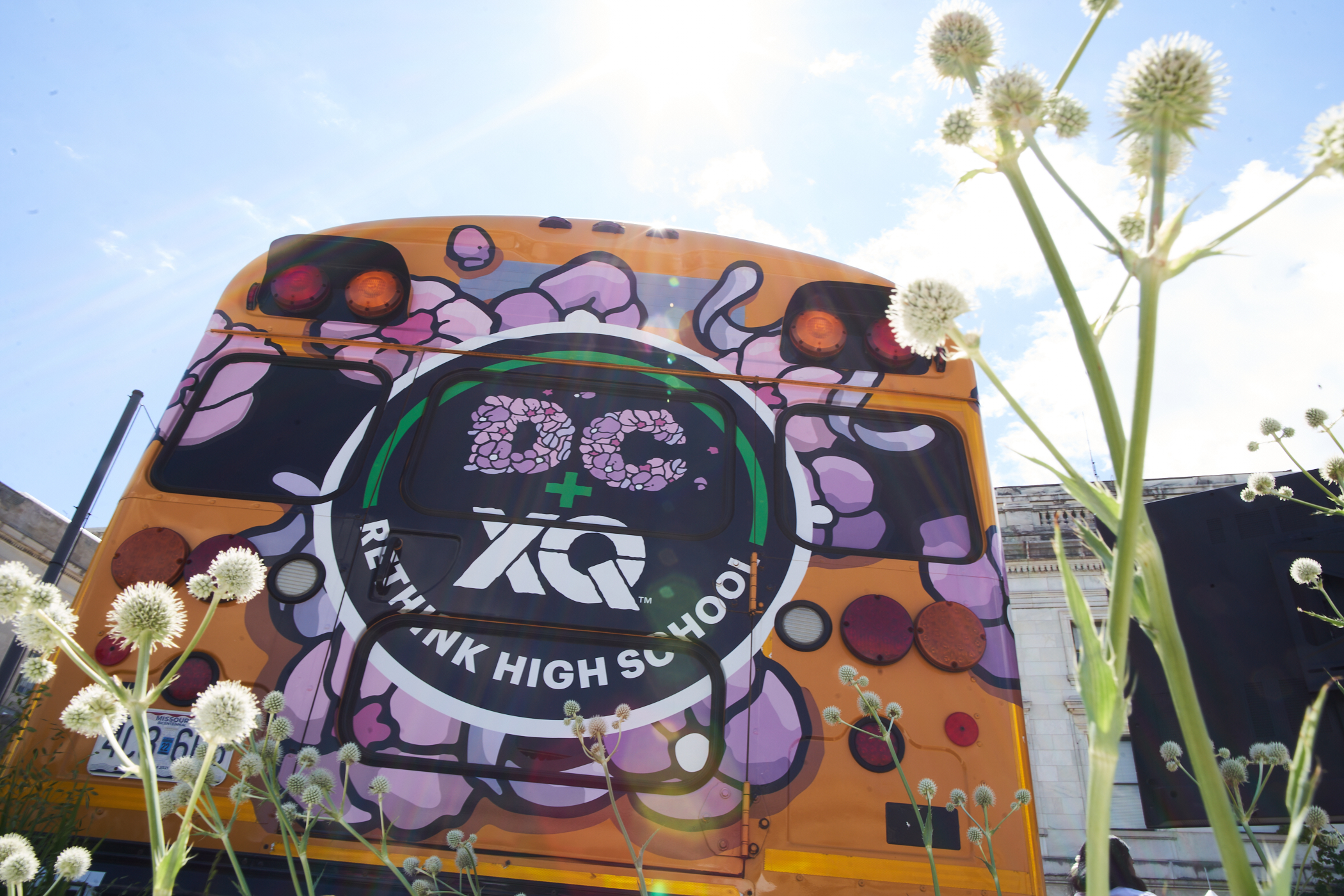XQ Design Principle: Smart Use of Space, Time, and Tech
Learning isn’t confined to a certain place, nor does it have to occur on a set…

Learning isn’t confined to a certain place, nor does it have to occur on a set schedule. Transformational high schools understand that the elements of time and space can be approached in new ways and that, sometimes, technology can support those new approaches. Smart use of space, time, and technology is one of the six XQ Design Principles. These principles show up at every XQ school, though how each school manifests is as unique as the environment and people involved.
Let’s explore what it means to incorporate a smart use of space, time, and tech.
What is a Smart Use of Space, Time, and Tech?
A smart use of space, time, and technology means looking at the structure of schooling—the buildings and classrooms, the schedule, and even the personnel and financial resources—with a fresh eye. It can mean taking a flexible, non-traditional approach to how these elements are arranged to meet students where they are and help them grow toward what they want to accomplish. It also means strategizing to access new spaces and opportunities, like expanding the classroom to the community. The goal is to leverage all of these elements to ensure students graduate ready for all that the future has to offer. Learn more about the XQ Learner Outcomes—the expanded and deepened knowledge, skills, traits, and mindsets students need to be fully prepared for college, career, and life.
“For too long, policymakers and educators have structured high school as though learning can only happen from 8 to 3, at a desk, in a classroom. But research tells us that learning can occur anywhere, at any time,.” explains Lauren Bierbaum, XQ’s head of data, research, and evaluation. “In fact, we know that rich and dynamic environments, full of tools that support young people in accessing, manipulating, and applying information, bolster learning. That’s why disrupting the orthodoxy around how schools structure time, space, and technology is so important.”
“My school is in downtown Grand Rapids, so a lot of our core projects are centered around community projects, like a neighborhood project where we worked with the homeless shelter. It was really cool to learn how this organization was so close even though I never knew about it.”
Haylee, Student, Grand Rapids Public Museum School
There are different approaches to using space, time, and tech smartly. Here are a few factors that school leaders should keep in mind when creating non-traditional, flexible uses of time, space, and technology:
- Align space, time, and tech with your mission: It’s important to explore creative and flexible uses of the school’s resources and people in a way that is strategic and helps realize the overall mission of the school. For instance, you might want to think about how space, time, and technology can be structured to help students become inquisitive, thoughtful, collaborative, caring, and reflective individuals who can succeed in life.
- Use data to drive improvement: Develop systems and data reflection points to allow everyone—educators, students, parents, community members—to evaluate the approach to time, space, and tech through an intentional cycle of learning, reflecting, and iterating. There is not a one time solve, rather schools should constantly evolve their approaches to nontraditional uses of time and space and bolster that with applications of technology.
- Make equity a touchstone: Establish and monitor how well your school is doing on inclusion in the community. This includes examining things like who has access to advanced learning opportunities or whether or not there is disproportionate representation in remediation or disciplinary action, and then iterate to address inequities.
- Prioritize learners to build an inspirational environment: Set up learning spaces in service of learners, one that is inspiring, collaborative, inviting, and learner-centered. Structures and policies can be developed to reflect the belief that the school belongs to the learners and should be physically designed with their needs and desires prioritized.
- Use time to focus on engagement: Time is one of a school’s most valuable resources, so approach it in ways that maximize learner agency and voice, enabling all learners to be their best selves. Ask students what they have learned about how structures of time and space help them learn both individually and collectively. More than that, by changing approaches to time, space, and tech, students can move through course work at their own pace. Nontraditional structurings of time, space, and tech may help your school implement competency-based learning campus-wide.
- Treat human capital as a strategic asset: In addition to tapping into student perspectives, build a team of adults who reflect the backgrounds, experiences, and identities of learners, families, and the community. You may find that traditional roles in your school may need to be more flexible and fluid as new priorities rise to the foreground. Find people who are invested in the school’s mission and building strong learner relationships characterized by trust and high expectations. Create a culture where leadership makes tough decisions strategically and always with the best interest of learners in mind.
How can smart use of space, time, and technology bolster other XQ Design Principles?
“We want students to take what they’re learning in the classroom and see the real-world possibilities. We want them to expand their sense of what they’re capable of accomplishing.”
Lillian Hsu, Founding Principal, Latitude High School
XQ’s six Design Principles help schools rethink how they can serve their students and better prepare their students to reach success in college and career. These guiding principles are foundational to the redesign process. However, they do not sit in parallel lines that don’t intersect, when implemented correctly the design principles interweave to underscore and bolster each other. Here’s a look at how a smart use of time, space, and technology can help bring XQ’s Design Principles into your school:
- Strong Mission and Culture. Exploring how to use time and space creatively helps schools connect and place their mission throughout the entire school community. For example, Elizabethton High School—an XQ school in Elizabethon, TN—school builders utilized their common space to create a mural about the history of the school and the school’s focus on community. This innovative use of space reminds students and educators of the school’s unique mission.
- Meaningful, Engaged Learning. Schooling too often takes place in vacuum. But, educators and students know that learning doesn’t. When schools reimagine how, when, and where learning can take place, they can engage students in different and better ways. Take Purdue Polytechnic High School—an XQ school in Indianapolis—as an example. At PPHS, students often leave the school building to work on projects that can’t be contained in the school’s walls. Last year, that meant students went outside to build, design, and test go-karts.
- Caring and Trusting Relationships. Remote learning and the COVID-19 pandemic reminded us how important relationships are to student success. The circumstances of remote learning also asked schools to build new infrastructures and to use technology innovatively to help foster student-teacher relationships.
- Youth Voice and Choice. Similarly, by deconstructing and rebuilding the architecture of school, school leaders can create schools where students feel empowered to use their voice to help guide their own learning and the trajectory of the school. A great example of this takes place at Círculos—an XQ School in Santa Ana, CA. Students at Círculos begin the day in circles, connecting with educators in less formal, non-traditional spaces, and are encouraged to take an active role in the trajectory of their own learning .
- Community Partnerships. Whether it means welcoming community members into your classrooms or sending students out into the community, community partnerships come with a unique approach to space. Learning doesn’t take place only at school, rather it is bolstered by the community outside of the school walls. For instance, Grand Rapids Public Museum School—an XQ school located in Grand Rapids, MI—is located in the Grand Rapids Public Museum and bolsters its lessons and projects by having students work directly with the museum’s archive.
Watch this video that explores how XQ schools make smart use of space, time, and technology.
What does a smart use of space, time, and tech look like in action?
“We’re going to have [students] tapped into the technologies as they are coming out in real-time rather than having them be twenty years behind.”
Stacy Kane, Co-Founder & Executive Director, Washington Leadership Academy
XQ schools take many different approaches to their smart use of space, time, and tech—here are a few to inspire you.
While Purdue Polytechnic High School renovated the PR Mallory Building (which is on the National Register of Historic Places), students got the opportunity to use a lab facility of industry partner Eli Lilly and Co. One student noted that “The hands-on experience in an actual research lab made me feel like what I was doing was important.”
Students at Elizabethton High School designed and constructed the school’s first outdoor classroom as a flexible place to learn during a time of unprecedented challenges brought on by the COVID-19 pandemic.
In small teams at Crosstown High, advisory groups meet up to three times per week, integrating technology platforms like Flipgrid. These sessions focus on goal setting, SEL skill-building, and relationship-building, and provide the space for students to receive ongoing feedback.
Latitude High School deepened student learning with Headrush, a learning management platform built specifically for learner-centered schools and project-based programs. This enables them to optimize for the fact that students start from different places, learn best by doing, and require better feedback loops.
Using Microsoft Power BI,Furr High Schooltracks student data trends to provide instructional coaching and counseling support in real-time.
How can educators use space, time, and technology smartly?
“We’re using a data-driven approach to bridge equity gaps that exist within our school community.”
Katie Cioe, Teacher, Ponaganset High School
Here are some tips for how to bring a smart use of space, time, and technology into everyday schooling.
- Take a creative view of your space. If your school is not yet ready to do a full-scalefull scale reimagining of its space, you can start in your own classroom. How can you make it accommodate a flexible approach to learning? What elements would make it inspiring to learners? Engage students in the process.
- Rethink how you allocate time. Perhaps you can’t jump directly to block scheduling, but can you find ways to build more concentrated time into your days? Consider how to use the time you have to foster deep understanding and mastery—what changes would that require?
- Offer to pilot a new approach. Explore whether your leadership would permit a trial of more flexible scheduling and space options. Work with like-minded colleagues to create a pilot to prove the value.
Learn more.
Explore the other XQ Design Principles.
Meet the XQ Schools.
Sign up for XQ Xtra, our biweekly newsletter for educators ready to rethink high school.









